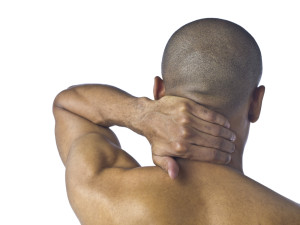 Computer users, those who work with their hands, or anyone simply under a good deal of stress may suffer upper back and neck pain.
Computer users, those who work with their hands, or anyone simply under a good deal of stress may suffer upper back and neck pain.
Injury, repetitive use, wear and tear, internal medicine problems and other conditions may cause irritation of the muscles, bones or nerves. Occasionally, extra bone growths or disk abnormalities may place pressure on nerves as they exit the spinal cord, causing nearby upper back muscles to contract, leading to muscle tightness and/or pain. There are more serious conditions affecting this area as well, some requiring surgery.
Instead of experiencing sharp pain, patients will often get used to this muscular stiffness, tightness, or decreased ability to move the neck. Trigger points— areas of muscle that stay contracted and partially compromise their own blood flow—are frequently present. Not uncommonly, those with certain headache patterns, TMJ/jaw joint dysfunction, ear-ringing, and/ or vague/unattributed lightheadedness/dizziness also suffer neck and upper back pain. [1]
Traditional Chinese Medicine (TCM) identifies “Liver Qi Stagnation” as one cause of tight bands/muscles in the neck/upper back. “Unbinding” this “stuck Liver Qi” with acupuncture and herbs can greatly reduce and prevent neck/upper back pain episodes/recurrences. TCM attributes “knots” in tight muscles to “accumulations of Phlegm, Qi and/or Blood”. Special treatments, especially Trigger Point Therapy, gua sha, cupping along with acupuncture and herbs diminish these tight knots and bands. [1] [2] [3]
Body acupuncture, Trigger Point Therapy, cupping, gua sha, Neurological Scalp Acupuncture, Chinese Herbal Medicine, and/or pharmaceuticals may all address this condition.
Learn more about Neck and Upper Back Pain
X
These brief overviews of conditions represent distillations of basic and current medical reviews from the following sources:
[1] Conventional Medical Sources
- “Essentials of Musculoskeletal Care”. Robert K. Snider and Walter B. Greene. American Academy of Orthopaedic Surgeons & American Academy of Pediatrics. 2nd Edition. (2001)
- “Travell & Simons’ Myofascial Pain and Dysfunction: The Trigger Point Manual”. David G. Simons, Janet G. Travell, Lois S. Simons, Barbara D. Cummings. Lippincott Williams & Wilkins; 2 edition (1998)
[2], [3]
- “Acupuncture Energetics: A Clinical Approach for Physicians”. Joseph M. Helms. Medical Acupuncture Publishers; 1st Edition. (1995)
- “Foundations of Chinese Medicine: A Comprehensive Text for Acupuncturists and Herbalists”. Giovanni Maciocia. Churchill Livingstone; 2 Edition (July, 2005).
- “Diagnosis in Chinese Medicine: A Comprehensive Guide”. Giovanni Maciocia. Churchill Livingstone; 1st Edition (January, 2004).
[4]
“Chinese Scalp Acupuncture”. Jason Ji-shun Hao, Linda Ling-zhi Hao and Honora Lee Wolfe. Blue Poppy Press; 1st Edition. (November, 2011)
